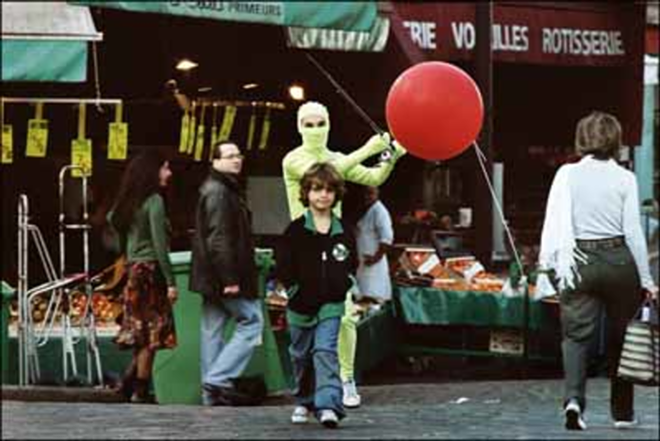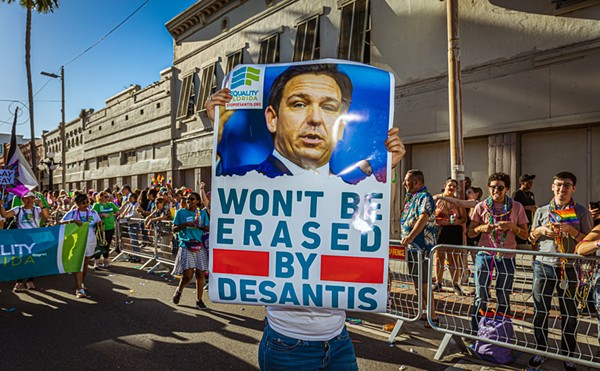
You don't really need to see Albert Lamorisse's The Red Balloon in order to appreciate the film it inspired, Hou Hsiao-hsien's Flight of the Red Balloon. In some ways, in fact, you may even be better off deliberately avoiding Lamorisse's 1956 classic, 34 minutes of charming effervescence that tend to make Hou's delicately contoured meditation look a little, well, dull.
There's an actual red balloon in both films, for what it's worth, and a young Parisian lad who treats the inanimate object as if it were a special friend. In Lamorisse's short, however, the crimson plaything floats front and center, a stand-in for youthful joie de vivre and the pleasures of pure imagination. In Hou's new film, it's reduced to a framing device that morphs into something more earthbound and consequently sadder, a melancholy metaphor for living with limits.
Unlike the youngster in Lamorisse's film, the little boy in Flight of the Red Balloon never even manages to connect with his inflatable object of desire. And soaring high above the rooftops of Paris on a veritable bouquet of balloons — as does the kid in the original short — is simply out of the question.
Hou, a Taiwanese auteur generally acknowledged as one of world cinema's leading lights, is an acquired taste, and his severe but exceedingly poetic style — full of long takes, minimalist dialogue and free-floating narratives — is evidenced from the first moments of Flight of the Red Balloon. The camera appears virtually static in that opening shot, but sharp eyes will gradually notice its slow, almost imperceptible motion: a glacial movement that keeps 7-year-old Simon (Simon Iteanu) in exactly the desired portion of the frame as he tries to coax down that uncooperative, titular balloon. Fidgeting against the Metro entrance, the boy pleads with the balloon to come play, a fairytale encounter Hao counterpoints with a whiff of the real world via the ceaseless crush of Paris traffic whirling around the boy and his toy.
Simon eventually tires of begging and disappears down the Metro steps, as the camera shifts its allegiance to the balloon drifting down to confirm whether the boy's really gone, then floating up past the trees, past the tops of buildings and monuments, and out of sight (opening moments sure to delight Lamorisse fans watching the red balloon revisit its old Paris haunts half a century later). As anthropomorphic as anything devised by Pixar, the balloon loiters around the city of lights, tentatively checking out the spots frequented by its boy, as uncaring adults bustle about, frowning and fondling their cell phones, too disconnected from childhood dreams (as in all the best fairy tales) to see the magic that's right in front of their faces.
These sequences may be the best thing in Hou's film. But the balloon soon disappears from the picture (rematerializing for only a few moments at the midpoint and end), and Flight of the Red Balloon moves on to examining other, more mundane signs of life. Don't be too disappointed, though. The mundane isn't always such a bad thing in Hou's cinema, which often sifts through reams of ordinary details in order to open our eyes to a single instant that reveals the sublime within everyday life.
No sooner does the balloon vanish than Taiwanese film student Song (Song Fang) steps off a bus and into the story, camcorder in hand, arriving in Paris to work as Simon's nanny. The boy needs minding because his frazzled mother, Suzanne (Juliette Binoche, slightly beefed-up and with yellow cotton candy hair), works long hours producing puppet shows about abandoned lovers going to extremes to rescue their paramours. Suzanne's something of an abandoned woman herself — which contributes to her frazzled condition — with an absent husband who's writing a novel abroad and doesn't seem much interested in returning.
Hou trains his patient, ever-attentive camera upon this household as the characters go about their business, the balloon peeping through the window periodically as if checking their progress. Song is the outsider here (an alien observer, like Hou himself), trying to make sense of her new environment through the eye of her camera. Suzanne works diligently with her puppets and argues with deadbeat neighbors, Simon takes piano lessons or zones out with his Playstation, and Song begins making a film based on, you guessed it, The Red Balloon.
All of this is basically just a framework for the characters to express themselves through improvised dialogue and an accumulation of details, and viewers without prodigious attention spans are likely to be put off by all this reveling in the quotidian. We spend most of our time simply watching the characters move through the space of Suzanne's apartment, a cluttered, intensely lived-in place crammed with objects that seem loaded with history and meaning. That's to be expected of Hou, who is all about location, location, location — exhibiting an almost Gallic appreciation of terroir (the connection between soil and what it produces) that roots his characters and to some extent defines them by a specific place.
The problem is that Hou ultimately comes off as a bit of a Taiwanese fish out of water in Paris, and his characters sometimes feel less than fully formed, their performances slightly tentative and overly muted. Commissioned by Paris' Musee d'Orsay, Flight of the Red Balloon is a lovely film, full of the eloquent artistry the director is known for, but it's also less emotionally engaged and, frankly, less ambitious than Hou's best work. All of which makes Flight of the Red Balloon an easy film to admire but a hard one to feel passionate about.














